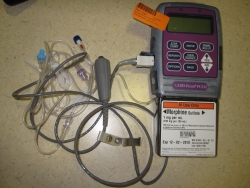You scored 0 marks out of 2.
This woman is suffering from opioid toxicity, one of the potential adverse effects associated with postoperative opioid analgesia. However, in surgery where nerve block techniques (using local anaesthetic agents) are not possible, opioids delivered IV or intrathecally represent one of the most effective forms of pain relief.

How should pain be controlled in patients in the immediate post-operative period? It is possible to provide effective analgesia with IV morphine whilst avoiding respiratory depression in all but a very small minority of patients by administering small doses of morphine (under 5mg) to patients every 5 minutes until pain relief is achieved.
This technique of titration according to pain is much safer than giving larger doses of opioids less frequently, and typically achieves rapid relief for the patients treated. Care should be taken to properly take into account the effects of the previously administered dose, so as to avoid over-medicating the patient.